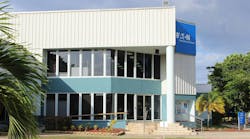As lamp manufacturers lead the way with smaller, brighter, and more energy-efficient sources, the real challenge lies with the U.S. ballast and fixture manufacturers that follow just a half step behind. Their new products designed around these cutting-edge light sources must enhance all the benefits of lamps, be user-friendly and, of course, inexpensive. These new offerings are likely to pay off as the specification community demands precise lighting effects from low-profile-if not virtually invisible-lighting equipment.
Fluorescent lamps. Slim T8 lamps equipped with electronic ballasts are becoming de rigueur in energy-conscious new office construction and retrofits, but the next generation is the waif-look T5 (Photo 1). Initial product offerings such as the Silhouette from Philips Lighting Co., Somerset, N.J., and the Pentron from Osram Sylvania, Inc., Danvers, Mass., focused mainly on under-shelf and display applications, but the new T5indirect office lighting fixtures seem well suited to the technology. T5 lamps provide a step forward in energy efficiency, and the smaller diameter allows a more optically precise asymmetric distribution.
Lam Lighting Systems, Santa Clara, Calif., is developing fixtures that can be suspended only 12-in. to 16-in. from the ceiling, compared to the current standard of 18-in. to 24-in., according to George Bosson, Lam Lighting's vice president and general manager. The objective is to keep the peak candlepower as close to the horizon of the fixture as possible, at about 20 degrees. "That allows us to bring the fixture closer to the ceiling without creating as much of a hot spot and still maintain the same fixture spacing," he says.
As indirect lighting systems make their way into spaces with lower ceiling heights, ballast manufacturers have to design efficient, low-THD ballasts with a low profile to fit into these fixtures. For instance, instead of a clunky F-can, the new X-package ballasts from Energy Savings, Inc. (ESI), Schaumburg, Ill., drive the T5 at the higher current it demands but with a height of only 18 mm. This is the exact dimension of the T5 lamp plus its lamp holder, according to ESI. "Now we're offering a product that can allow the fixture design to be controlled by the lamp and the lamp holder, rather than the ballast size," says Ron Bezdon, an ESI product manager. ESI also offers ballasts only 1-in. high for T8 systems.
Ledalite, Langley, British Columbia, is marketing two linear indirect lines, Minuet and Crescendo, for T8, T5 and twin-tube compact fluorescent lamping. Both are less than 21/2-in. high and offer a direct-indirect option.
Slide down the scale another 3/8 in. to arrive at the ultrathin T2 lamp from Osram Sylvania. Pam Horner, the company's manager of technical education, explains that OEMs are interested in the lamp for low-profile under-cabinet and case lighting, where the primary sources now used are hot and inefficient halogen and xenon strip lights. "We offer an energy-saving product that has a very small profile, so that the optical system could be smaller and minimize fixture size," Horner says.
Alkco Lighting Co., Franklin Park, Ill., introduced several fixtures utilizing the T5 lamps and now offers the Slite T2 under-shelf light (Photo 9), which won "Best New Product" at last year's Lightfair trade show in New York, N.Y. The complete luminaire is 3/4-in. by 11/8-in. and comes in several standard lengths. The tiny diameter of the T2, when placed inside a reflector, begins to take on the qualities of a point source, but is linear, says Scott Roos, Alkco's vice-president of marketing and product development. "Though I'm not going to call it a specular point source, displayed objects under this system start to look very good and not quite as flat as they might with larger fluorescent sources," he says.
Another option in this product area with T5 or T2 lamping is the Tru-Lux series offered by Starfire Lighting, Inc., Jersey City, N.J. (Photo 2). The line includes valence, cove, sconce, linear spot and linear-flood fixtures.
Alkco's Scott Roos also sees some non-illumination advantages to pee-wee lighting: "I think the cost of manufacturing is going to come down," he says. "We may see, as manufacturers, more opportunities to automate the assembly of fixtures." In addition, smaller fixtures require fewer raw materials, less finishing, less packaging, lower freight charges and often feature easier installation. These factors may seem small, but they add up across the industry. "Project this even a little further, and I think the environmental impact of building a lighting fixture is going to be less."
HID. Energy efficiency and related environmental concerns were, again, the driving force behind the incredible amount of research and development it took to domesticate high-intensity discharge (HID) lamps. The major lamp manufacturers (some utilizing a ceramic arc tube) now offer low-wattage, high-efficacy, long-life metal-halide families with good color rendering, improved color stability over life, and better color consistency lamp-to-lamp. "There's been a growing market for lower-wattage metal halides for some time," says Terry McGowan, worldwide application development manager, GE Lighting, Nela Park, Ohio. Osram's HQI lamps led this trend, but today PAR lamps tend to be the most popular shapes in these families. "The applications tend to be display and downlighting, and you're getting a very nice directed beam, a package that people understand," McGowan says.
But it's Philips Lighting's Master-Color family that seems to be the choice among specifiers (Photo 6). The diverse family of 3,000K MasterColor lamps has moved indoors into powerful but small downlights and track heads. MasterColor lamps come in the familiar PAR20, PAR30, and PAR38 shapes (among others). However, incorporating a ballast into a low-profile fixture sometimes proved difficult.
"They've done a good job with the lamp, but the gear has a tendency to be almost as big as the light source," says Tony Donato, track product designer, Lightolier, Providence, R.I. He disagrees with the approach of using a conventional track-head shape and adding the ballast on. Instead, he would prefer to see more manufacturers "take these components and package them so they become as compact as possible. This gives the architect something that will enhance his architecture, not detract from it. By taking a new source and really integrating all of it, it becomes a superior product," Donato says.
Lumiare Design and Manufacturing Co., Westlake Village, Calif., has followed a similar approach to its new line of landscape lighting equipment with MasterColor lamps. Small-scale fixtures are a consistent design approach throughout the Lumiare product line, and the Coronado PAR20 is no exception (Photo 5). "When we found out that the lamps were becoming available several years ago, we designed a fixture that was unique and in the same idea as the lamp-very sleek, very tiny, and sort of powerful looking," says John Baldasti, the company's vice president of sales. The Coronado accent lighting line (PAR20, PAR30, and PAR38) can be mounted in landscaping (indoors or out) or on buildings. Its intent is to draw attention to whatever is being lighted, rather than the light fixture itself.
This aesthetic principle of lighting is increasingly shared by architects, lighting designers and interior designers. Their demands during the advent of modern architecture have helped bring these petite light sources into existence. "What we're talking about is clean design, clean planes, visual clarity," explains lighting designer Ken Ventry of Focus Lighting, New York, N.Y. "Being able to use smaller equipment for residential applications now has become a real interest of clients.... The lamp technology allows you to tuck away these small fixtures and still get the lighting effect you're looking for."
Ironically, these high-tech miniaturized sources also have their place in period design and historical renovations. Carefully concealed accent lighting can subtly bring out fine appointments and finishes, while an overabundance of large ceiling apertures or incongruous visible lighting equipment can instantly ruin a carefully restored ambiance.
The advantage to many of the lower-wattage metal halides is their ability to deliver many more lumens per watt from a familiar PAR-lamp package. Ann Kale of Ann Kale Associates, New York, N.Y., recently completed a lighting design for a school library using MasterColor PAR20s in downlights recessed into a 20-ft ceiling. "The downlights are so good at delivering the necessary footcandles to the task surface, it allowed us more leeway in choosing the decorative fixture we wanted for the ambient lighting," she says. "The decorative fixture doesn't have to work as hard."
Kale consistently seeks the fewest, smallest downlights possible for her designs. Again, the onus is on the manufacturer to deliver all the power and good-quality lighting from these lamps through a 4-in.-or-less ceiling aperture. The new Portfolio commercial specification-grade series of open downlights developed by Cooper Lighting, Elk Grove Village, Ill., accepts the 35W PAR20 and 70W ED17 metal halides in 4-in. apertures. The complete line of matching 4-in., 6-in., 73/8-in. and 91/2-in. apertures accommodates dozens of source configurations from a 50W MR16 adjustable accent to a two-lamp 42W triple-tube compact fluorescent wall washer.
Portfolio adjustable accents include a mechanism that keeps the center of the beam aligned with the center of the aperture. In some accent fixtures, as the lamp tilts, part of the beam bounces off the reflector or trim back into the fixture, defeating the purpose of these high-efficiency, high-impact, miniaturized sources. "We still want the drama, but let's see how efficient we can make the product," adds Dave Doubek, Cooper's market manager for specification products.
Compact fluorescent lamps (CFLs). Compact fluorescent lamps have gotten progressively smaller through the years. "We started with just single PLs in 5W, 7W, 9W and 13W," says Rochelle Kimball, a San Francisco-based lighting application consultant for Philips. Then, she says, two, three and four tubes were shrunk down and piled onto the same base, with different manufacturers using several configurations. Today, the dominant product used to replace incandescent lamps is the triple-tube, up to 42W. By bringing fluorescent technology down into the realm of point-source incandescents, compact fluorescents usually produce four times the light-per-watt of energy consumed and last up to 13 times longer. "The difference is staggering," Kimball says. "There was a push toward energy efficiency while still wanting that look of incandescence."
Vertically mounted 32W and 42W triple-tubes allow downlight manufacturers to shrink the ceiling aperture down to 6-in., but this creates a narrow distribution and often more holes in the ceiling. Janet Nolan, principal of J.S. Nolan + Associates Lighting Design, San Francisco, Calif., explains that horizontal-mount compact fluorescent downlights can achieve a wider distribution and better uniformity, but because of their large ceiling aperture risk more glare.
For its line of CFL downlights, Prescolite-Moldcast, San Leandro, Calif., advertises exceptional 55 degrees cutoff of the lamp and the lamp image using the proprietary Virtual Source reflector design. For general lighting, these fully loaded (two 42W triple-tubes) 9-in. downlights match the illumination of 2-ft-by-2-ft, two-lamp parabolic troffers, fixture for fixture.
Compact fluorescent fixtures are now coming out of hiding in hundreds of decorative pendants, surface-mount luminaires, ADA-compliant sconces, and even new torchieres. The U.S. Consumer Product Safety Commission has linked numerous fires and several deaths to halogen torchieres, which by their compact nature burn exceedingly hot. Emess Lighting, Ellwood City, Calif., has worked with the Lawrence Berkeley National Laboratory, Berkeley, Calif., to develop a three-way-switched CFL torchiere. At a fraction of the wattage and at much cooler temperatures compared to halogen, the output of CFL torchieres produces as many or more lumens in a soft, even distribution. The Emess portable lamps utilize two flat double-twin-tube CFLs from Osram (36W Dulux F).
Numerous manufacturers offer consumers integrally ballasted compact fluorescents, some with dimming capabilities. Their warm colors, instant start, and flicker-free operation (along with a push from energy codes) make CFLs more readily accepted in homes, restaurants, and hotels.
Some EW readers may have heard about the twisty Heliax lamp from GE Lighting, which had a light distribution very similar to A-lamps. GE discontinued the lamp because of quality control problems in high-speed manufacturing processes and high production costs. Litetronics International, Alsip, Ill., is still marketing the screw-base Spiral-Lite in smaller lumen packages.
Fiber optics. When asked how much further the miniaturization of lighting components could go, Janet Nolan of Nolan + Associates immediately brought up fiber optics, which can produce points and lines of light less than 1 mm across. "It's a very exciting technology, but it's got a long way to go," she says.
Though it has been used in a wide range of applications, fiber optics is not today a viable system for general lighting. There are limits to the amount of light some conductors can carry and to the efficiency of the illuminator-conductor coupling (even using the lollipop-sized, mega-lumen sulfur lamp). "We did a project for a very high-end jewelry store, and we used fiber optics to light the jewelry display cases," she says. "But we were lighting little tiny diamond rings, necklaces and baubles, so we didn't need something that provided a huge amount of candlepower or a large beam spread." She added that many of the technical limitations of fiber optics would likely be overcome, someday.








